A sleeping pad may make you feel it is too warm but the real reasons for such an impression are usually completely different. So keep reading to learn more.
Sleeping pads are used for comfort and to separate you from the ground, no matter if the ground is cold or warm. So a pad itself is not a heater and it can never be too warm.
However, an insulated pad may indeed have a higher temperature than an uninsulated air pad. Namely, if this is about inflatable pads, an uninsulated pad is filled with air that circulates, and this air may be cooled from the ground so the pad may feel cooler than an insulated pad.
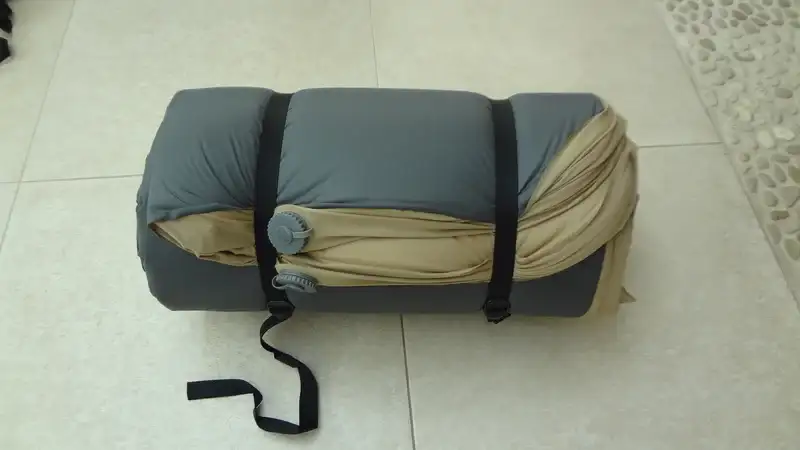
Before posting this text in my site, I actually put the question from the title to Grok and also to ChatGPT. Guess what, they both replied with ‘yes, a sleeping pad can be too warm’. However, I disagree with this.
So, can you use a high R-value sleeping pad in summer?
To answer this question, it is necessary to know terminology first. So here just to stress that this R is a convenient parameter which tells you how good your pad will insulate you from the ground.
The term ‘high R-value’ may not be completely clear. So, if you have a pad that has an R-value above 4 or 5, you can be sure it is good for winter camping or for sleeping at high elevations in general.
Below you can see my Sea to Summit Camp Plus Self-Inflating Mat, its R-value is 4.3, and I use it in summer in the mountains.
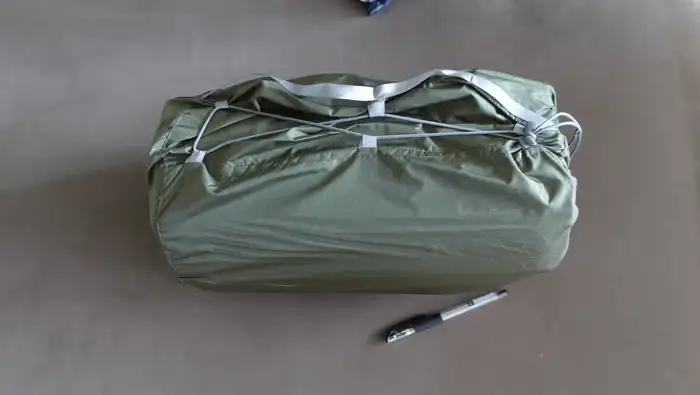
Now we can answer the question in the sub-title above, and the answer is simple – yes, you can use a high R-value sleeping pad in any season. A sleeping pad does not heat you. Its main purpose is to prevent your body warmth to be lost to the cold ground. So this is an insulator or a heat transfer barrier if you like.
But let’s assume that the ground is warmer than your body, would a pad work even in this situation? The answer is yes. This is about blocking heat exchange, no matter which direction the heat goes and which side is warmer or colder.
What temperature do you need a sleeping pad for?
From what I have described in the previous section, you will need a sleeping pad whenever there is a considerable difference between your body temperature and the ground temperature. This is all simple physics and heat exchange. The heat will flow from a warmer area to a colder area.
Now, when you sleep in a sleeping bag, the insulation of the bag will at least partly prevent this heat loss. I say ‘partly’ because its insulation is compressed with your body and it largely loses its insulating property.
So to some extent, the sleeping bag itself will be enough. As you probably know, sleeping bags also come with a temperature rating. However, this sleeping bag’s rating holds only assuming that you have an appropriate sleeping pad. Make sure that you do not overlook this fact.
But for what temperature difference do you really need a pad? I have seen some suggesting numbers, but I do not think there is anything exact here. We all react on the cold differently.
At REI, they suggest the following table:
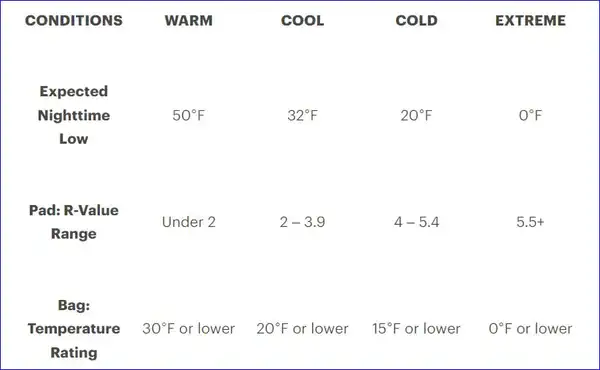
Normal body temperature is 98.6 F (37 C), so now you can only guess when you may need a pad. Air temperature in the case of summer camping may be very high, it may go over 100 F, but the real question is what the ground temperature is. This is something you do not know and cannot predict.
So what remains as options is the following:
- Try in practice and you will know when it is time to add a sleeping pad. But bear in mind this is also about comfort, so you would want a pad in any case.
- Play safe and use a sleeping pad in every situation, then you do not need to guess. This is definitely wise to do when it is about camping. But if you are on the trail you will want to reduce pack’s weight, this is where you would make some compromises.
What makes a sleeping pad insulated?
It may surprise you but this is mainly about air. But the story is not so simple. As you know, inflatable sleeping pads with only air inside, are usually not for cold weather. Why?
This is because of possible large scale convection inside the pad. Air molecules are heated by the upper side of the pad and they move around and then give this energy to the bottom side. So they are cooled and they cool the upper side, and you feel cold.
I have experienced this in practice just a few weeks ago during my stay in the Dolomites. I was sleeping in the car a few times, and I had a 20 cm thick inflatable sleeping pad. I did not use a sleeping bag in the standard way because I feel claustrophobic.
This is why I unzipped my bag and used it as a blanket. This was at high elevations, around 2000 meters or so, summer time, and I was cold from below.
So the air plays a big role for insulation, but its movement must be reduced. This is why closed cell foam pads are such great insulators even when the pads are very thin.
In other words, the insulating features of a pad are due to air combined with some added material which can be foam, down, or various synthetic fibers that keep the air in place and prevent its large scale movement.
Though there are some clever technologies and designs where the pad is with reflective layers inside that prevent heat loss.
The Therm-a-Rest NeoLoft Sleeping Pad (picture below) should be one of them. I am not really sure what inside of this pad is. The only way to know would be to cut it through. They write about ContourCore Matrix minimizing convective heat loss due to two stacked rows of triangular chambers.
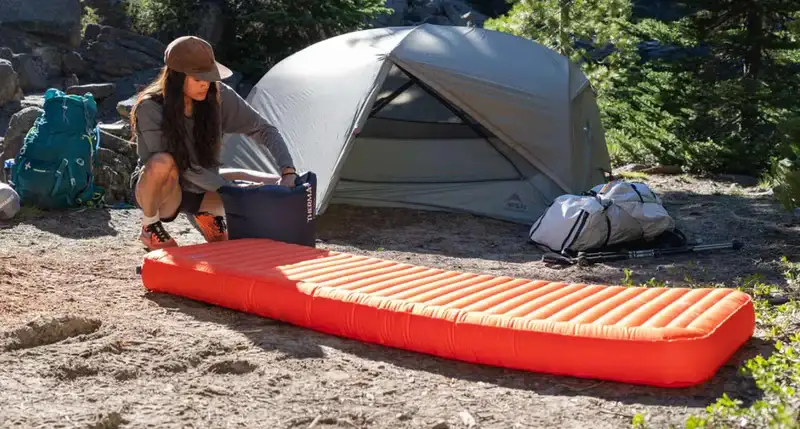
This incredible pad is almost 12 cm thick, yet it packs incredibly well, and its R-value is 4.7. See how it looks when ready for transportation:
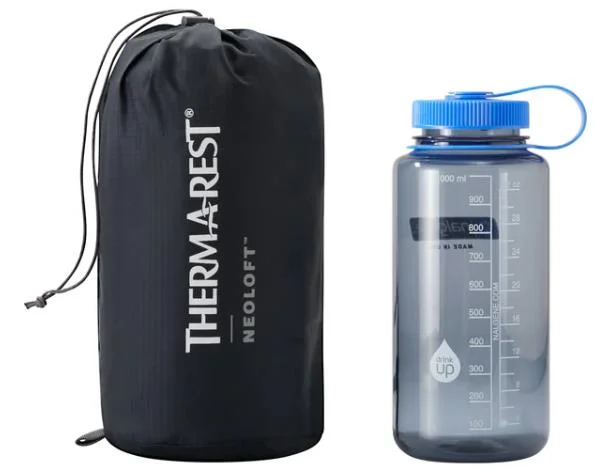
But why the main question from the title? Why and how your sleeping pad can make you feel too warm?
I would start from the usual situation when you sleep in your bed at home. In summer time, when you sleep in your bedroom, I do not think that you blame you mattress when you feel warm. The mattress may add to the feeling of warm though, but this is not the main factor.
The same is with outdoor sleeping pads. I am sure you would feel less warm if you sleep on a simple foam pad than on a self-inflating pad. The latter is normally made of a non-breathable and air-tight material. So this is a synthetic material, and it is not pleasant when you sweat.
Most likely even your mattress at home is synthetic, but it is breathable and you also use bedclothes. Well, do the same with your outdoor bed and use a cover for the pad if you do not sleep in a sleeping bag.
Some good outdoor sleeping pads come with a cover included in the package. The picture below is my own DoD Soto Sleeping Pad that comes with such a cover. As you see, it includes also a self-inflating pillow with a zippered cover.
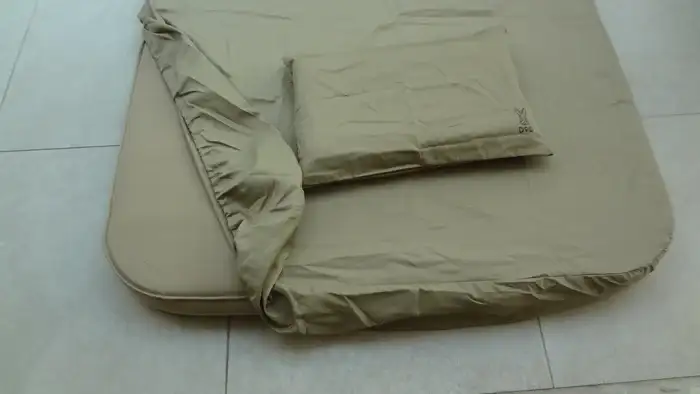
But there may be more to this. If the pad is a simple uninsulated air inflatable type, and the ground is cooler than the surrounding air, it is likely that the air in the pad will be with the temperature that is somewhere in between the ground temperature and the surrounding air temperature.
This means that this pad will be cooler than the air around you, and it may be more pleasant to you than an insulated pad, if you sleep naked and you are in a direct contact with the pad.
More tips to consider
• Consider pad materials: Some pads have reflective coatings or insulation layers that may feel too warm. Look for pads with better breathability or cooling designs for warmer trips.
Closed-cell foam pads tend to be less warm compared to self-inflating or air pads with thermal insulation.
• Ventilation: Some sleeping pads, especially those with air chambers or foam, can trap heat more than others. Mats with better air circulation or those made from materials that breathe might be more suitable in warmer conditions.
• Sleeping bag compatibility: The combination of your sleeping pad and sleeping bag can lead to excessive warmth if both are too insulating for the conditions. Sometimes, you might need to choose one with less insulation if the other is very warm.
• Personal comfort: Everyone’s body temperature regulation is different. What might be too warm for one person might be just right for another. Also, your activity level before sleep, what you wear, and the type of sleeping bag you use can influence how warm you feel.
You might want also to see this video on how to choose a sleeping pad, please have a look:
Final thoughts
In summary, the question ‘Can a Sleeping Pad Be Too Warm’ is a bit misleading because the pad does not heat you, it only insulates you from the ground.
If it is warm in the place where you camp, it is likely that you will feel warm even if the pad is with a very low R-value. This is about your sweating caused by the warm environment and about the pad’s synthetic and non-breathable material.
So the issue of sweating you solve by removing the blanket or by allowing the body to ventilate, and the issue of a non-breathable pad’s material you solve by using a pad cover.
But as explained above, a simple air pad may feel cooler because air in it may be cooled by the ground. This is why you might not want to use a winter pad for summer camping. However, I have not seen any study related to this issue.
Thank you for reading. For more texts of this type please check under the category FAQs here in the site. In particular, read my text about backpacking and hut-to-hut tours differences.
Subscribe to my weekly newsletter, this will keep you informed because I add texts here regularly. Let me know if you have questions or comments, there is a comment box below. Have a nice day.
Leave a Reply